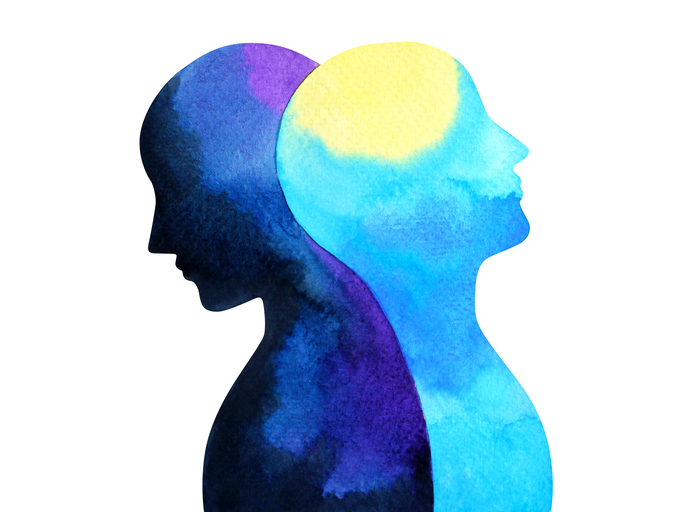 Bipolar, formerly known as manic depression, is characterized by mood dysregulation. In this condition, an individual often alternates between unusually high moods (mania or hypomania) and low moods (depression). The intensity of these moods can cause much distress. Mood swings can also interfere with a person’s ability to function.
Bipolar, formerly known as manic depression, is characterized by mood dysregulation. In this condition, an individual often alternates between unusually high moods (mania or hypomania) and low moods (depression). The intensity of these moods can cause much distress. Mood swings can also interfere with a person’s ability to function.
There are three types of bipolar: bipolar I, bipolar II, and cyclothymia. The types differ on the intensity and frequency of each mood phase. People with any type of bipolar can benefit from therapy. Treatment can help an individual manage their moods and prevent symptoms from becoming more severe.
SYMPTOMS OF BIPOLAR MANIA AND HYPOMANIA
People with bipolar can experience periods of extreme emotion and activity called mania. During a manic episode, a person can get an "on top of the world" feeling called euphoria. They may feel excessively happy or confident, even if the situation doesn’t call for it. This extreme enthusiasm may push the person toward risky behaviors such as excessive gambling or spontaneous sexual encounters.
More often, however, the person feels irritable rather than happy. A person may become angry if others prevent them from acting on their desires (even if said desires are likely to cause harm or pain). Symptoms of irritability are especially likely if the person has been using substances.
By definition, mania disrupts a person’s ability to function at a job or maintain relationships. Extreme manic episodes can sometimes lead to psychotic symptoms such as hallucinations or delusions. Mania may require hospitalization to prevent harm to oneself or others.
To qualify as mania, the extreme mood must last at least one week and be present for most of each day. A person must also show unusual energy levels or goal-directed activity. Lastly, an individual must show three or more of these symptoms:
- Inflated ego and/or self-esteem. (Example: A person has delusions of grandeur, believing they are destined to rule the world.)
- Increase in goal-directed activity. (Example: A person begins building several inventions despite having no engineering knowledge.)
- Decreased need for sleep. (Example: A person wakes up after only 3 hours of sleep feeling completely rested.)
- Racing thoughts/flight of ideas. (Example: A person feels they are thinking faster than they can speak their ideas.)
- Pressured speech. (Example: A person may speak incredibly quickly, perhaps too quickly to understand.)
- Increased distractibility. (Example: A person cannot focus on a conversation due to faint background noise.)
- Reckless behavior(s) which may impact one's financial, social, or physical wellbeing. (Example: A person spends their savings on a car they don’t need and normally wouldn’t want.)
Hypomania is a milder version of mania. Hypomanic episodes tend to be shorter in duration, lasting four days or more. Its symptoms are the same as the manic criteria listed above. Yet hypomania rarely prevents a person from functioning on a day-to-day basis. If a person develops psychosis or needs to be hospitalized, then their symptoms qualify as manic.
SYMPTOMS OF BIPOLAR DEPRESSION
The depressive phase of bipolar is the opposite of the manic phase. A person will often feel extreme sadness, emptiness, or self-hatred. They often lose motivation or interest in any activity. Like mania, bipolar depression often causes significant distress and impairment.
The criteria for a depressive phase are the same as those for major depression (MDD). The only difference is that bipolar depression occurs in tandem with manic or hypomanic symptoms.
To qualify for a depressive episode, symptoms need to be present for two weeks or more. A person with bipolar depression will have at least five of the following symptoms:
- An empty, hopeless, or sad mood that is present for most of the day, nearly every day.
- Changes in appetite or weight (weight may increase or decrease by more than 5% in a month).
- Changes in sleep (insomnia or hypersomnia).
- Fatigue or loss of energy.
- Psychomotor agitation (restlessness or other increased motion) or psychomotor depression (slowing down of movement).
- Difficulty remembering, making decisions, and/or concentrating.
- Excessive feelings of worthlessness or guilt.
- Recurrent thoughts of death or suicide.
TYPES OF BIPOLAR
The Diagnostic and Statistical Manual (DSM) recognizes three main types of bipolar: Bipolar I, Bipolar II, and Cyclothymia.
Bipolar I is the only type in which mania is present. People with bipolar I can also experience hypomanic or depressive episodes, but these are not required for a diagnosis. A person only needs to have one episode of mania in their lifetime to qualify for bipolar I. That said, 90% of people who have one manic episode will have another. Over half of manic episodes are immediately followed by a depressive episode.
Bipolar II involves hypomania and depression. If an individual develops mania (5-15% of people with bipolar II do), then their diagnosis shifts to bipolar I.
Contrary to popular belief, bipolar II is not a milder version of bipolar I. While the hypomanic symptoms tend to be less severe, the depressive phases are often longer and more frequent. Bipolar II tends to be more chronic than bipolar I and involve more mood episodes overall.
A person may have several depressive episodes before experiencing their first hypomanic episode. Nearly 12% of people with bipolar II are first diagnosed with major depression. Once hypomania occurs though, the diagnosis shifts to bipolar II.
Cyclothymia describes when a person has chronic, fluctuating mood episodes which don’t meet the criteria for hypomania or depression. For example, a person may have only two depression symptoms instead of the required five.
To be diagnosed with cyclothymia, an adult must experience both high and low mood episodes for at least 2 years. (Children and teens only need to have symptoms for one year.) A person must be experiencing a mood episode more often than not. If the person experiences breaks between episodes, those symptom-free periods are no longer than 2 months.
Cyclothymia symptoms are often milder than those in bipolar I or bipolar II, but they can still cause distress. A person may also struggle with the prolonged nature of their mood issues. According to the DSM, someone with cyclothymia has a 15-50% chance of developing bipolar I or II later in life.
TIMING: RAPID CYCLING, SEASONALITY, AND MIXED EPISODES
Certain variations of bipolar can affect the timing of one’s symptoms. These variations include bipolar with rapid cycling, bipolar with seasonal pattern, and bipolar with mixed features.
Rapid Cycling: Individuals with bipolar I and bipolar II often have three or fewer mood episodes a year. If someone has four or more mood episodes in twelve months, they are said to be rapid cycling. The episodes may have large breaks of “normal” mood in between (2 months or more). A person could also switch immediately between mania and depression.
 Seasonal Pattern: Some people may have mood episodes at a certain time of year. For example, a person may have a manic episode every spring and go into remission in the summer. Having seasonal episodes of one polarity does not mean the opposite phase will also be seasonal, though it can be.
Seasonal Pattern: Some people may have mood episodes at a certain time of year. For example, a person may have a manic episode every spring and go into remission in the summer. Having seasonal episodes of one polarity does not mean the opposite phase will also be seasonal, though it can be.
Around 15-22% of people with bipolar have seasonal mood episodes. The most common pattern is for people to develop depression in fall or winter, then have a remission in spring. Younger individuals and those who live at higher altitudes are more likely to have winter depression.
Mixed Episodes: People with bipolar typically experience manic and depressive episodes separately. But some individuals have depression and mania/hypomania symptoms at the same time. These instances are called mixed episodes. To qualify for a mixed episode, a person must meet the full criteria for one phase (manic or depressive) and show at least three symptoms of the opposite phase.
GETTING THE RIGHT DIAGNOSIS: MDD V.S. BIPOLAR DEPRESSION
Many people with bipolar develop depression symptoms years before their first manic or hypomanic episode. As such, many people with bipolar are misdiagnosed with major depression. An estimated 25% of people diagnosed with MDD may actually have bipolar.
The diagnoses can be difficult to distinguish at first. However, if a person shows the following signs, their depression is likely to be bipolar in nature.
- The person develops symptoms before puberty OR after giving birth.
- The depressive episodes occur frequently and last for a brief time.
- The person has a family history of bipolar.
- The person develops manic symptoms after trying antidepressants.
It is important for someone with bipolar to get the correct diagnosis as soon as possible so they can get proper treatment. Some treatments for MDD, such as antidepressants, may worsen someone’s mood issues. With appropriate treatment, however, a person can begin to recover from their bipolar symptoms.
BIPOLAR AND RELATED CONDITIONS
Bipolar often occurs alongside other mental health conditions. Certain types of bipolar are more likely to be comorbid with specific issues.
- Substance Abuse: Alcohol or drug addiction is common among all types of bipolar. Substance abuse occurs in over half of people with bipolar I and 37% of people with bipolar II.
- Anxiety: Anxiety issues (phobias, social anxiety, etc.) are common in bipolar I and II. Anxiety occurs at a rate of 75% for both bipolar I and II.
- ADHD: Attention-deficit and hyperactivity issues are common among adults with bipolar I and children with cyclothymia.
- Eating and Food Issues: Around 14% of people with bipolar II have an eating or food issue. Binge eating is more common than bulimia or anorexia.
People with bipolar II are likely to have multiple co-occurring issues. Over half of people with bipolar II have three or more comorbidities. Certain diagnoses may be more prominent during specific phases. Eating issues and anxiety can be heightened during the depressive phase, while substance abuse has been linked to hypomanic symptoms.
Bipolar can be a serious condition, especially when it occurs alongside other diagnoses. However, bipolar is treatable. With the right therapist, an individual can greatly improve their quality of life.
References:
- American Psychiatric Association. (2013). Diagnostic and statistical manual of mental disorders: DSM 5 (5th ed.). Arlington, VA: American Psychiatric Publishing, Inc.
- Bipolar disorder. (n.d.). National Alliance on Mental Illness. Retrieved from http://www.nami.org/Learn-More/Mental-Health-Conditions/Bipolar-Disorder
- Bipolar disorder among adults. (n.d.). National Institute of Mental Health. Retrieved from http://www.nimh.nih.gov/health/statistics/prevalence/bipolar-disorder-among-adults.shtml
- Bipolar disorder statistics. (n.d.) Depression and Bipolar Support Alliance. Retrieved from https://bit.ly/2CCdUVA
- Roecklein, K. A., Rohan, K. J., & Postolache, T. T. (2010). Is seasonal affective disorder a bipolar variant? Current Psychiatry, 9(2), 42-54. https://www.ncbi.nlm.nih.gov/pmc/articles/PMC2874241
- Tipsheet: Bipolar depression versus unipolar depression. (2014, August 20). Psychiatric Times. Retrieved from http://www.psychiatrictimes.com/bipolar-disorder/tipsheet-bipolar-depression-versus-unipolar-depression

